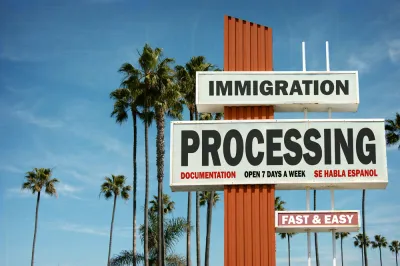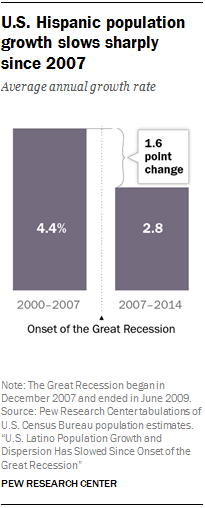A comprehensive study on Latino population growth in the U.S. has been released by Pew Research Center based on a study of 2007-2014 census data. Two factors are responsible for the slowing growth: reduced fertility and immigration rates.

In June 2012, a Pew Research Center study indicated that "Asians have surpassed Hispanics as the largest wave of new immigrants to the United States," (also posted here). Now Pew has released a detailed study with accompanying infographics and fact sheets to gain a better understand of how the nation's largest ethnic minority has been changing since 2007.
"Between 2007 and 2014, the U.S. Hispanic population grew annually on average by 2.8% (its pace of growth has been an even slower 2.4% between 2010 and 2014)," writes the authors of the study, Renee Stepler and Mark Hugo Lopez.

Courtesy of Pew Research Center
This was down from a 4.4% growth rate between 2000 and 2007 and down from 5.8% annually in the 1990s. As a result, the Hispanic population, once the nation’s fastest growing, has now slipped behind Asians (whose population grew at an average annual rate of 3.4% from 2007 to 2014) in its growth rate. [Asians has surpassed Hispanics in 2013 as the fastest growing minority group].
As for all the campaign talk about "securing the borders," when it comes to Mexico, Pew reported last year that "from 2009 to 2014, more Mexicans and their families (including U.S.-born children) left the U.S. for Mexico...than left Mexico to come to the U.S."
The main driver of Latino population growth in the U.S. shifted from immigration in the last two decades of the last century to births in the oughts. Birth rates declined almost 27 percent from 2006 to 2014.
- Despite slowing population growth, Latinos still accounted for more than half (54%) of the nation’s population growth between 2000 and 2014.
The report also centers on geographic population dispersal, "beginning in the 1990s, just as Latino population growth was accelerating."
- The South continues to lead in Hispanic population growth, but three fastest growing counties are in North Dakota [as of 2014].
- The five states with the largest Hispanic populations are California (15 million), Texas (10.4 million), Florida (4.8 million), New York (3.7 million) and Illinois (2.2 million). Together, these states hold 65% of all Hispanics.
- See more 'key facts about how the U.S. Hispanic population is changing.'
Additional information:
- Associated Press: Study: Latino population growth slips behind Asian Americans
- Pew Research Center: Hispanic/Latino Demographics
FULL STORY: U.S. Latino Population Growth and Dispersion Has Slowed Since the Onset of the Great Recession

National Parks Layoffs Will Cause Communities to Lose Billions
Thousands of essential park workers were laid off this week, just before the busy spring break season.

Retro-silient?: America’s First “Eco-burb,” The Woodlands Turns 50
A master-planned community north of Houston offers lessons on green infrastructure and resilient design, but falls short of its founder’s lofty affordability and walkability goals.

Delivering for America Plan Will Downgrade Mail Service in at Least 49.5 Percent of Zip Codes
Republican and Democrat lawmakers criticize the plan for its disproportionate negative impact on rural communities.

Test News Post 1
This is a summary

Test News Headline 46
Test for the image on the front page.

Balancing Bombs and Butterflies: How the National Guard Protects a Rare Species
The National Guard at Fort Indiantown Gap uses GIS technology and land management strategies to balance military training with conservation efforts, ensuring the survival of the rare eastern regal fritillary butterfly.
Urban Design for Planners 1: Software Tools
This six-course series explores essential urban design concepts using open source software and equips planners with the tools they need to participate fully in the urban design process.
Planning for Universal Design
Learn the tools for implementing Universal Design in planning regulations.
EMC Planning Group, Inc.
Planetizen
Planetizen
Mpact (formerly Rail~Volution)
Great Falls Development Authority, Inc.
HUDs Office of Policy Development and Research
NYU Wagner Graduate School of Public Service


























